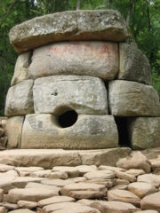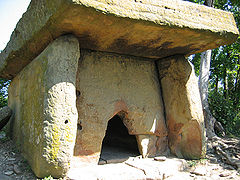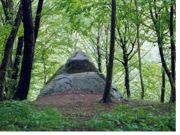
Dolmens of Russia
Encyclopedia

Megalith
A megalith is a large stone that has been used to construct a structure or monument, either alone or together with other stones. Megalithic describes structures made of such large stones, utilizing an interlocking system without the use of mortar or cement.The word 'megalith' comes from the Ancient...
s, dolmen
Dolmen
A dolmen—also known as a portal tomb, portal grave, dolmain , cromlech , anta , Hünengrab/Hünenbett , Adamra , Ispun , Hunebed , dös , goindol or quoit—is a type of single-chamber megalithic tomb, usually consisting of...
s and stone labyrinths have been found (but little studied) throughout the Caucasus Mountains
Caucasus Mountains
The Caucasus Mountains is a mountain system in Eurasia between the Black Sea and the Caspian Sea in the Caucasus region .The Caucasus Mountains includes:* the Greater Caucasus Mountain Range and* the Lesser Caucasus Mountains....
, including the Abkhazia
Abkhazia
Abkhazia is a disputed political entity on the eastern coast of the Black Sea and the south-western flank of the Caucasus.Abkhazia considers itself an independent state, called the Republic of Abkhazia or Apsny...
. Most of them are represented by rectangular structures made of stone slabs or cut in rocks with holes in their facade. These dolmens cover the Western Caucasus
Western Caucasus
The Western Caucasus is a western region of the Caucasus in Southern Russia, extending from the Black Sea to Mount Elbrus.-World Heritage Site:...
on both sides of the mountain ridge, in an area of approximately 12.000 square kilometres of Russia
Russia
Russia or , officially known as both Russia and the Russian Federation , is a country in northern Eurasia. It is a federal semi-presidential republic, comprising 83 federal subjects...
and Abkhazia.
The Caucasian dolmens represent a unique type of prehistoric architecture, built with precisely dressed large stone blocks. The stones were, for example, shaped into 90-degree angles, to be used as corners or were curved to make a circle. The monuments date between the end of the 4th millennium and the beginning of the 2nd millennium B.C.
While generally unknown in the rest of Europe, these Russian megaliths are equal to the great megaliths of Europe in terms of age and quality of architecture, but are still of an unknown origin. In spite of the variety of Caucasian monuments, they show strong similarities with megaliths from different parts of Europe and Asia, like the Iberian Peninsula, France, Great Britain, Ireland, Netherlands, Germany, Denmark, Sweden, Israel and India. A range of hypotheses has been put forward to explain these similarities and the building of megaliths on the whole, but still it remains unclear.
Approximately 3,000 of these megalithic monuments are known in the Western Caucasus
Western Caucasus
The Western Caucasus is a western region of the Caucasus in Southern Russia, extending from the Black Sea to Mount Elbrus.-World Heritage Site:...
, but more are constantly being found, while more and more are also being destroyed. Today, many are in great disrepair and will be completely lost if they are not protected from vandals and general neglect.
Architecture of Russian dolmens

Dolmen
A dolmen—also known as a portal tomb, portal grave, dolmain , cromlech , anta , Hünengrab/Hünenbett , Adamra , Ispun , Hunebed , dös , goindol or quoit—is a type of single-chamber megalithic tomb, usually consisting of...
s have a limited variety in their architecture.
The floor plans are square, trapezoidal, rectangular and round. All of the dolmens are punctuated with a portal in the centre of the facade. While round portholes are the most common, square ones are also found. In front of the facade is a court that usually splays out, creating an area where rituals possibly took place. The court is usually outlined by large stone walls, sometimes over a meter high, which enclose the court. It is in this area that Bronze and Iron Age pottery has been found - which helped date these tombs -, along with human remains, bronze tools and silver, gold and semi-precious stone ornaments.
The repertoire of decoration for these tombs is not great. Vertical and horizontal zigzags, hanging triangles and concentric circles are the most common motifs. One decorative motif that is quite common is found across the top of the porthole slab. It can best be described as a lintel held up by two columns. Pairs of breasts, done in relief, have also been found on a few tombs. These breasts usually appear above the two columns of the porthole decoration. Perhaps related to these are the stone plugs, which were used to block the porthole, and are found with almost every tomb. They are sometimes phallic-shaped.
Some unusual items associated with dolmens are big round stone balls, double balls and animal sculptures.

Black Sea
The Black Sea is bounded by Europe, Anatolia and the Caucasus and is ultimately connected to the Atlantic Ocean via the Mediterranean and the Aegean seas and various straits. The Bosphorus strait connects it to the Sea of Marmara, and the strait of the Dardanelles connects that sea to the Aegean...
coast in the Krasnodar area
Krasnodar Krai
-External links:* **...
near Gelendzhik
Gelendzhik
Gelendzhik is a resort town in Krasnodar Krai, Russia, situated on the Gelendzhik Bay of the Black Sea, between Novorossiysk and Tuapse . Greater Gelendzhik sprawls for along the coastline and covers an area of 122,754 ha...
, Russia
Russia
Russia or , officially known as both Russia and the Russian Federation , is a country in northern Eurasia. It is a federal semi-presidential republic, comprising 83 federal subjects...
. In this area there is a great concentration of all types of megalithic sites including settlements and dolmen cemeteries. Large stone mounds surrounded the two monuments.
The central dolmen is rectangular in plan, 4 x 4 meters, while the two flanking dolmens are circular, 4 and 5 meters in diameter. The two round dolmens had been bulldozed - probably in the 1950s - in order to harvest the surrounding trees, but the main structure of the central dolmen had not been damaged.
Another (fourth) dolmen near the Zhane River has a secret entrance at the back of the chamber, and a façade, dummy entrance and courtyard at the front of the dolmen. There in addition to these pristine dolmens were some ruined dolmens.
Other Russian megalithic sites
Other important megalithic sites of Russia have been found along Russia’s northern shores with the White SeaWhite Sea
The White Sea is a southern inlet of the Barents Sea located on the northwest coast of Russia. It is surrounded by Karelia to the west, the Kola Peninsula to the north, and the Kanin Peninsula to the northeast. The whole of the White Sea is under Russian sovereignty and considered to be part of...
and the Barents Sea
Barents Sea
The Barents Sea is a marginal sea of the Arctic Ocean, located north of Norway and Russia. Known in the Middle Ages as the Murman Sea, the sea takes its current name from the Dutch navigator Willem Barents...
as well as at Vera Island.

